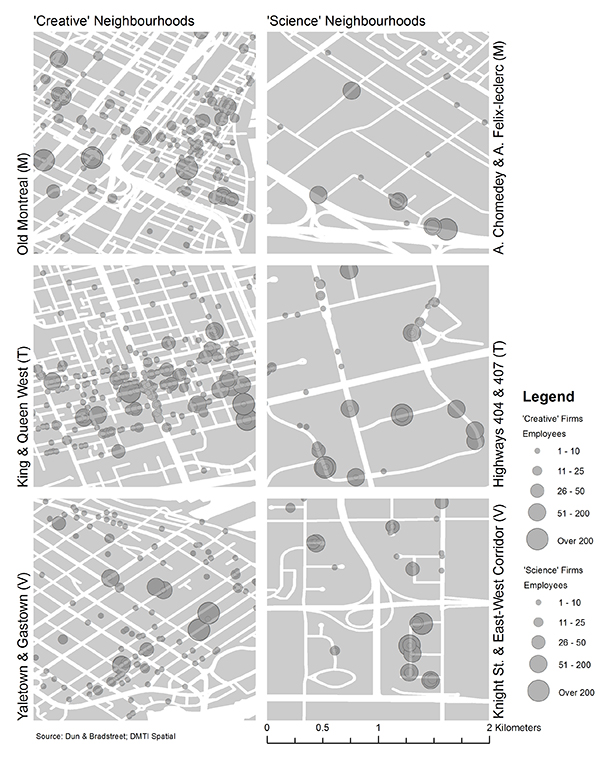In the 1990s, in the early days of the internet, the common prediction was that cities would become obsolete. New technologies would unshackle us from traditional work locations, allowing us to ‘telecommute’ from wherever we pleased. Twenty years later, not only are our largest cities generating the most and best new jobs, they are concentrated in very specific neighbourhoods depending on the industry.
My new study looks at the locations of two distinct types of knowledge-economy businesses – arts & culture and science & technology – within the cities of Montreal, Toronto, and Vancouver. These three regions are home to 35% of the country’s population but 57% of ‘creative’ industry employment and 55% of ‘science’ industry employment. At the neighbourhood level, these cities have very similar business location patterns with creative businesses clustering in dense, walkable neighbourhoods near the city core, and science businesses preferring car-dependent suburban environments (see Figure 1).
Figure 1: Knowledge neighbourhoods in Canadian cities

The patterns of where workers in these two industries tend to live could not be more different. People in creative industries tend to reside in the same neighbourhoods in which they work. While those employed in science industries tend to live in the suburbs, but not in the same neighbourhoods that they work. In the case of the former, the live-work overlap is possible due to the mixed-use make-up of older central areas of each city. In contrast the post-war suburbs were planned with the mantra of separating land uses.
Spotting these geographic patterns is relatively straightforward, explaining them is far more complicated. The common denominator is knowledge itself. Businesses in both industries succeed by developing new ideas and turning them into products. The difference is that art is not ‘done’ in the same way as science. Think back to your high school experience and recall how your drama class was taught in contrast to chemistry and you get the basic idea. Drama class required a lot of interaction with your classmates, as collaborators and as critics. In chemistry, while your lab partners were important, you could do most of your studying alone at home with your textbook. Drama class was fluid and unpredictable. In chemistry you learned the foundations and steadily progressed to more complex assignments.
Learning, of course, does not stop once we are finished with our formal education. It continues throughout our careers. And not just within our workplaces but between them. This is a key point where creative and science industries diverge. Creative businesses tend to be smaller and function around relatively short-term projects. Self-employment is also significantly more common. This necessitates a greater degree of cooperation between companies. Teams are constantly formed and dissolved. Social relationships, while important in all industries, take on an even higher level of importance in the creative industries. People with ‘creative’ jobs have on average the largest and most diverse social networks of any type of profession. It is no accident then that creative businesses still choose to be in high density, mixed-use neighbourhoods in big cities. These environments offer the best prospects for forming the relationships necessary for competing in the modern creative economy. Coffee shops, music venues, and public spaces are just as important as formal offices and studios. The line between live and work is often hard to distinguish.
Location matters for science-based business, too, but in much different ways. They need to be in locations that have large numbers of highly educated workers. They also benefit from being close to leading edge research institutions such as top ranked universities. Science-based businesses tend to be bigger and more self-contained. Knowledge is a much an asset to be protected as it is something to be shared. While the choice of city matters, the qualities of the neighbourhood itself may matter less. And so cheap and flexible space in a non-descript suburb often suits them just fine.
But this landscape may be changing. New research by the Martin Prosperity Institute at the University of Toronto shows that tech start-ups receiving venture capital are increasingly choosing city-centre locations over the suburbs. Young workers often prefer to live and work in such environments and tech is incorporating increasing amounts of creativity and design as the industry shifts from hardware to software and standalone applications give way to social networks. Just as the relationship between the creative and science industries is getting closer, so too it seems is the geography.
My research offers three key lessons for economic development policy. The first is that cities are going to increasingly be the main driver of the knowledge-based economy. They facilitate the relationships that fuel creativity and innovation by providing the common space to do so. Cities act as gateways to other places in the world bringing opportunities for exchange. The second lesson is that city centres will continue to be the focal points of the knowledge economy. Dense, mixed-use, walkable neighbourhoods maximize the possibilities of social interaction and learning. Their complexity and chaos induce serendipitous connections that spark new ideas. Finally, the suburbs will need to find ways to become more urban. Traditional single-use office park developments and isolated corporate campuses will likely struggle. Efforts need to be made to intensify and diversify employment lands, preferably around transit hubs that provide access to a wider swath of the city.
As the economy changes, our policies and many of our attitudes will need to change with it. Global competition is here and it is very unforgiving. Despite the connectivity offered by the Internet, cities are increasingly the key unit of competitive advantage as companies and talented individuals seek out the most advantageous locations. The good news for Canada is that its cities currently compare quite favorably. But we cannot afford to be complacent. If we are to thrive as a nation in the 21st century we must ramp up our investment in cities.
Download this Report (PDF)